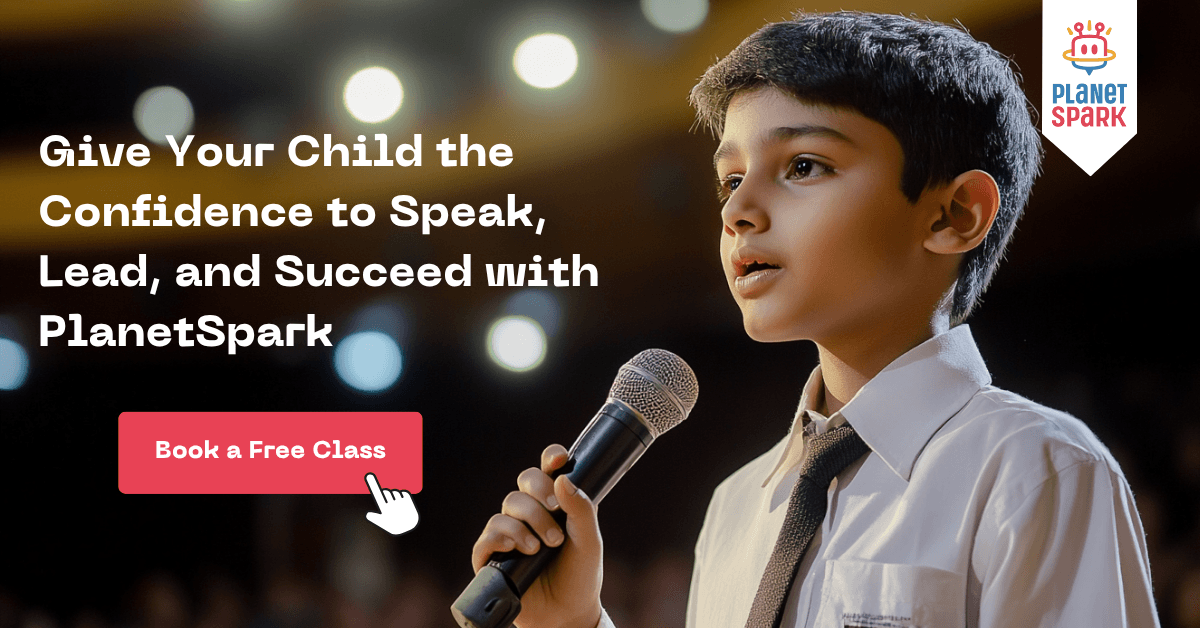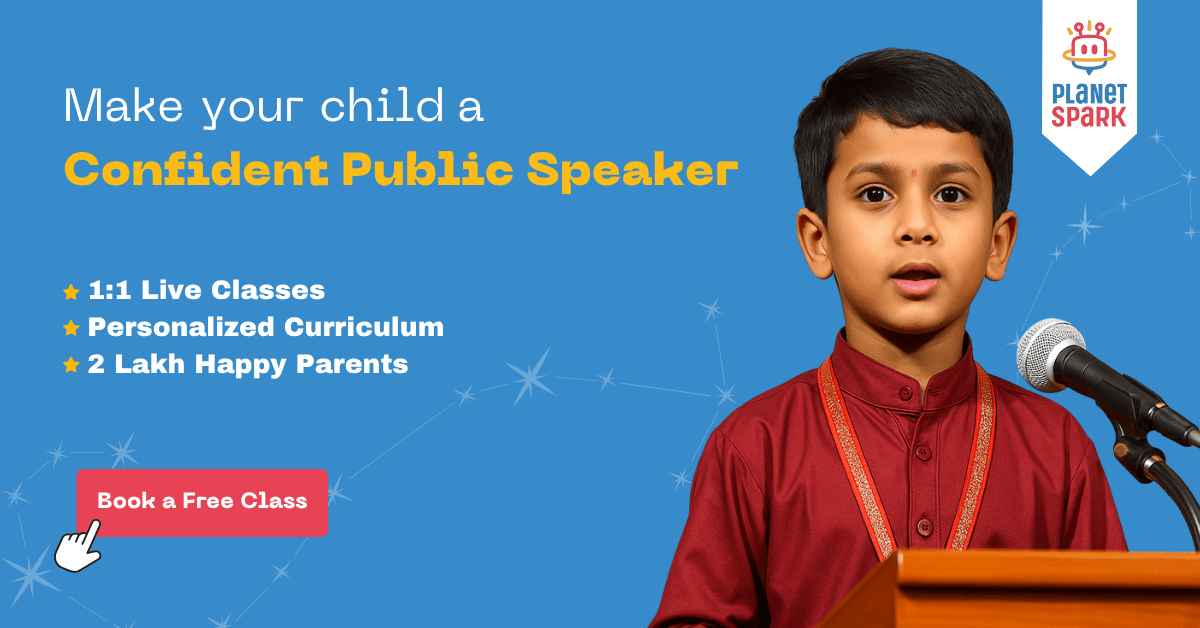How to Start a Speech: 15 Best Ways and Tips for Students

Table of Contents
- Why Is the Start of a Speech So Important?
- 15 Effective Ways to Start a Speech for Students
- Speech Opening Examples for Kids
- How to Choose the Right Speech Opening
- PlanetSpark’s Secret to Confident Speech Openings
- Pro Tips to Practice Your Speech Opening
- Conclusion: Start Strong, Speak Boldly
- FAQs: How to Start a Speech
The first few seconds of a speech matter more than most people realize. Whether it’s a classroom audience, a school competition, or a formal stage, the way a speaker opens their speech sets the tone for everything that follows.
For children, this moment can feel both exciting and nerve-wracking. Will people listen? Will they remember what I said? At PlanetSpark, we help kids conquer these doubts and begin their speeches with confidence, clarity, and creativity.
If you're wondering how to help your child start a speech powerfully or if you're a student reading this to prepare for your next speaking opportunity, this blog will walk you through everything you need to know.
Why Is the Start of a Speech So Important?
When you begin a speech, you’re not just sharing information. You’re inviting your audience to listen. The opening sets the tone, builds curiosity, and determines whether your message will make an impact.
In fact, studies show that people decide within the first 10 to 20 seconds whether to fully pay attention to a speaker. That means if your opening isn’t strong or memorable, you risk losing your audience even if the rest of your speech is brilliant.
For kids, especially in school settings, starting with confidence can instantly boost their self-esteem and command respect. But here’s the good news: speech openings can be learned, practiced, and mastered with the right guidance and structure.

15 Effective Ways to Start a Speech for Students
Here are some powerful, kid-friendly methods your child can use to start their speech with confidence and creativity.
1. Start with a Powerful Quote
A well-chosen quote can give weight to your message right from the start.
Example:
Mahatma Gandhi once said, "Be the change you want to see in the world." Today, I want to talk about how we can bring that change, starting with kindness.
2. Ask a Thought-Provoking Question
Questions spark curiosity and make the audience reflect.
Example:
Have you ever imagined what the world would look like without trees?
3. Use a Surprising Fact or Statistic
This grabs attention and makes your audience eager to hear more.
Example:
Did you know that by 2050, there could be more plastic in the ocean than fish?
4. Tell a Short Personal Story
Storytelling creates connection and relatability.
Example:
When I was six, I was afraid to speak in front of my class. But then one small experience changed everything.
5. Paint a Vivid Scenario
Help your audience imagine something intriguing.
Example:
Close your eyes. Picture a world where robots do your homework, cook your meals, and even take your exams.
6. Use Humor
A light, age-appropriate joke can warm up the room.
Example:
I once asked my dog for public speaking advice. He just barked and ran away. Guess I’m on my own today.
7. Begin with a Riddle or Puzzle
Riddles ignite curiosity, especially among younger audiences.
Example:
What has a tongue but cannot talk? A shoe. But today, I’m going to talk about the power of using our real voice.
8. Use a Sound or Physical Prop
A small action or sound effect can immediately draw attention.
Example:
A student claps loudly and says, "That’s how fast the climate is changing before you even blink."
9. Start with a Repetition
Repeating a phrase can build rhythm and emphasis.
Example:
We need courage. We need confidence. We need communication. And that’s what public speaking is all about.
10. Use a Bold Statement
Shock your audience gently into paying attention.
Example:
School should be banned. Yes, you heard me right, but only the boring kind.
11. Role-play or Become a Character
Acting or impersonation can instantly engage listeners.
Example:
Ladies and gentlemen, I am Albert Einstein. And today, I want to share the formula of curiosity.
12. Use Audience Participation
Get them involved from the first second.
Example:
Raise your hand if you’ve ever felt nervous before a speech. Great. Now keep your hands up if you want to beat that fear today.
13. Link It to Current Events
Using recent news makes the speech feel timely and relevant.
Example:
As we watched rockets land back on Earth this week, one thing became clear. Our future is more exciting than ever.
14. Start with Dialogue
Opening with a mini conversation can feel fresh and dynamic.
Example:
Mom, I’m scared to speak in class.
You’ve got this, champ.
And here I am, proving her right.
15. Start with Silence and Eye Contact
Sometimes, a pause says more than words.
Tip:
Walk confidently, pause for 3 seconds, smile, look around, and then begin. You’ve already won their attention.
Speech Opening Examples for Kids
Here are a few ready-to-use openings tailored for common school topics.
Topic: Save Water
Imagine waking up one day, turning the tap, and nothing comes out. That future is closer than we think.
Topic: Importance of Discipline
What if rules didn’t exist? No classes, no homework… sounds fun? Let’s see what happens next.
Topic: Independence Day
If our freedom fighters were here today, what would they say about the India we’ve built?
Topic: Digital Addiction
Have you ever checked your phone without realizing it? Me too. And that’s exactly why we need to talk.
How to Choose the Right Speech Opening
Not every speech opener fits every occasion. Choosing the right way to begin your speech can depend on your audience, the topic, the format of the event, and your personal speaking style. Here's how to guide your child (or yourself) toward picking the perfect opening:
Know Your Audience
The first step to choosing the right speech opener is understanding who will be listening. Is your child speaking in front of teachers during a school assembly, peers in a classroom, or judges in a competition?
For formal events like national celebrations, opt for respectful, impactful openers like quotes, questions, or a relevant fact.
For casual class presentations, children can use humor, personal anecdotes, or a fun riddle to connect with their classmates.
For competitions, the opener should be attention-grabbing and slightly dramatic to make a strong impression quickly.
Knowing the audience helps avoid tone mismatches and builds better engagement from the very beginning.
Know the Tone of the Topic
The topic of the speech also plays a major role in shaping the introduction. Some topics are inherently serious while others allow for playfulness and creativity.
For light-hearted topics such as "My Pet" or "The Funniest Day of My Life," use humor, role play, or personal stories to entertain and engage.
For informative or serious topics like "Climate Change" or "Importance of Education," begin with a compelling fact, statistic, or quote to show the gravity of the subject.
For inspirational speeches like "Never Give Up" or "Believe in Yourself," consider opening with a story of struggle and triumph or a motivating quote that reflects the speech’s theme.
Helping children understand the emotional tone of their topic will guide them toward a fitting and powerful opener.
Practice Different Options
Children should experiment with two to three different openers for the same speech and try them out loud. This helps identify which version feels the most comfortable, engaging, and natural to deliver.
Record each version and review them together.
Ask a sibling, parent, or friend for feedback: “Which version grabs your attention the most?”
Encourage the child to trust their instinct. If they feel confident and connected with one, that's likely the right choice.
Practicing options helps eliminate stage fear and boosts overall performance.
Stay Age-Appropriate
An opener that works for a high school student may confuse or overwhelm a younger child. Children should always choose examples, stories, jokes, or references that match their own age and comprehension level.
Avoid overly complex quotes or abstract facts.
Choose topics and expressions they relate to from daily life, like school experiences, cartoons, or family moments.
Humor should be innocent, light, and easy to understand for their peers.
If the audience doesn’t understand the opening, the speech loses its impact, so it’s best to keep things clear and child-friendly.
Keep It Short
The goal of the opening is to grab attention, not to explain everything. The best openings are usually under 30 to 40 seconds, just long enough to set the stage and create interest.
Avoid starting with long paragraphs or too much background information.
Use short, punchy sentences or one strong story element to create impact.
Teach children to pause briefly after the opener to let the audience absorb the moment.
A strong but concise opening leaves the audience eager to hear more, which is exactly what a great speech should do.

PlanetSpark’s Secret to Confident Speech Openings
At PlanetSpark, we believe that great speeches begin with great confidence, and that begins with structured training.
Our Public Speaking Program for Kids is designed to help children aged 6 to 14 master every element of speech delivery, including:
What Makes PlanetSpark Unique
1:1 Expert Mentorship with trained communication coaches
Personalized Learning Paths that suit every child’s comfort level
SparkX Events for real-world practice on stage and online
Gamified Lessons to make learning fun and effective
Practice and Feedback Tools, including videos and parent-teacher reports
Weekly Speaking Challenges, debates, and storytelling sessions
With over 20 lakh kids trained, our goal is simple. To make every child a confident, fearless speaker starting from their very first word.
Explore PlanetSpark’s Public Speaking Course
Pro Tips to Practice Your Speech Opening
Once your child has picked an opening, here are a few ways to practice and perfect it.
Mirror Practice. Watch your own facial expressions and gestures.
Voice Recording. Playback helps identify pauses and tone issues.
Start with Siblings or Friends. Get real-time reactions from a small audience.
Use Cue Cards. Keep just the first line handy while memorizing the rest.
Focus on Delivery. Use pauses, volume shifts, and confident body language.
Conclusion: Start Strong, Speak Boldly
The start of a speech is your chance to shine, to captivate, connect, and conquer stage fear. With the right techniques, a little creativity, and structured practice, every child can learn to open their speech like a pro.
And if you’re looking for a trusted partner in your child’s communication journey, PlanetSpark’s Public Speaking classes are designed to unlock their potential, one confident sentence at a time.
Ready to see your child own the stage?
Join PlanetSpark today and start your journey toward confident communication.
FAQs: How to Start a Speech
Q1: What is the best way to start a speech in school?
Start with a quote, question, fact, or story that relates to your topic and grabs attention within the first few seconds.
Q2: How do I write a good speech introduction?
Begin with a hook, give a quick context, and state your main idea or argument clearly.
Q3: Can I start a speech with a joke or story?
Yes. Jokes and stories make your speech engaging. Just ensure they’re appropriate and relevant.
Q4: How to start a speech for a competition?
Use a strong opening like a bold statement or powerful question to stand out immediately.
Q5: What are some attention grabbers for speeches?
Quotes, questions, props, surprises, dialogue, sound effects, or even silence.
Q6: How does PlanetSpark help kids with speech openings?
Through expert-led, one-on-one coaching, guided practice, SparkX speaking events, and personalized feedback systems.
Personalized Communication Report
Record a video to get a AI generated personalized communication report for your child

Hi There, want to try these
tips for your child with
LIVE with our expert coach?
Let's check your child's
English fluency
